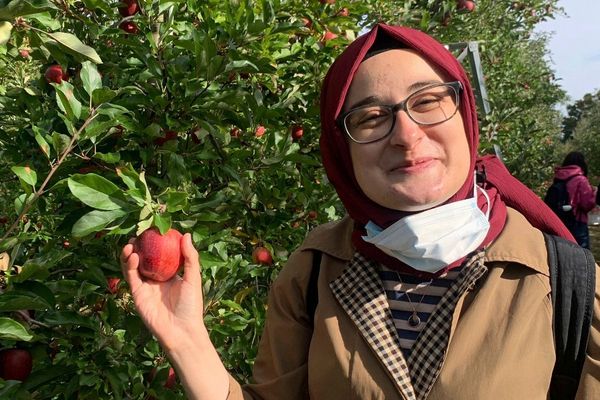The newsletter delves into the evolution of The Hindu Data Team from single-topic podcasts to a comprehensive series exploring the shifting landscape of student admissions in medical institutions
For some time now, The Hindu Data Team has been at the forefront of producing data-focused podcasts. Sonikka Loganathan anchored all these podcasts. One of our most popular episodes is ‘Data and dams: How Kerala cracked flood management’. In this episode, we engaged with the manager of Kerala’s Idukki dam, exploring how the State managed to prevent floods and associated fatalities despite heavy rainfall in August 2022, especially considering the devastating deluge of 2018.
Additionally, our miniseries on caste discrimination within IITs and IIMs, comprising part 1 and part 2, has received over 4,000 listens for each segment. For more insights into the myriad issues we have covered over the past year, do visit our podcast channel on Spotify.
After a year of producing podcasts on single topics with typically one to three interviewees, the format began to feel a tad repetitive. This prompted the idea of initiating a more extended podcast series. I’ve long been intrigued by the field of medical education and its challenges. When the National Eligibility-cum-Entrance Test was introduced, I made multiple Right to Information (RTI) requests in order to understand the changing landscape of student admissions. My primary concern revolved around how the exam, seemingly tilted in favour of those attending coaching classes, might put students from less privileged or rural backgrounds at a disadvantage.
Regrettably, most of my RTI queries met with rejection, leaving us in the dark, data-wise. This lack of data fuelled the concept of interviewing doctors to shed light on the direction medical education is headed in, especially its implications for health care. We aimed to understand the broader picture directly from professionals by speaking to doctors from diverse backgrounds.
Yet, this initiative wasn’t without challenges. The primary task was to assemble a varied group of doctors to ensure diverse opinions. It was notably challenging to secure an interview with a State board-educated MBBS student. Further, devising the questionnaire brought its own set of dilemmas: determining the episode’s themes, ensuring consistent questioning, and addressing potential non-responses.
Eventually, a structured set of questions was developed, and each participant was subjected to it, with additional questions derived from their responses. After concluding the interviews, which extended over two weeks owing to numerous reschedulings, they were transcribed using online tools.
Upon analysing the transcripts, recurring themes became apparent. Many doctors expressed their opinions on the evolving methods of conducting MBBS admissions and the inherent challenges. These takeaways were recorded on a large whiteboard, and it was then that we grasped coherently the scope of the project. These discussions organically shaped the episodes, from addressing the changing dynamics of MBBS admissions to discussing the rural healthcare gap and intricacies of the MBBS curriculum.
After this rigorous process, each episode’s narrative was drafted, weaving in the interviewees’ answers, segmented for relevance, and interspersed with the hosts’ analyses.
Accompanying each episode will be a printed story featuring a QR code link to the podcast. This comprehensive effort concluded our endeavour, prompting a temporary break from pursuing a similar series soon.
The inaugural episode of ‘Vital Signs’ will be released this Sunday. Stay updated by subscribing to the Data Point podcast channel on Spotify, Sticher, Apple podcasts or The Hindu website.
Recap
- Climate justice activists have been campaigning for the world’s economically developed countries to raise their investments in climate adaptation and mitigation, including paying for other countries’ ability to deal with the effects of climate change. Data showed that while countries in Sub-Saharan Africa, Latin America, and South Asia have historically contributed the least to global warming, they are bearing the bigger brunt of climate disasters — both in terms of extreme natural phenomena and debt distress.
- On June 1 this year, 14-year-old Indian-American Dev Shah won the Scripps National Spelling Bee title. Looking at the frequency ratings of a winning word (the average of how frequently the word was found in books published in a 20-year period), data showed how the contest was getting more difficult each year. For instance, the winning word for the 1940 edition of the contest was ‘Therapy’, while in 2023, it was ‘Psammophile’.
- As the fourth story in a series of Data Points that examined inter-district differences in the southern States of India, we looked at data from Telangana. Given that the State was formed barely a decade ago, the frequency of data across many indicators was poor. Yet, data revealed a stark difference in socio-economic indicators between the districts around Hyderabad, the State capital, and those far away from it. For instance, while more than 35% of women married as teenagers in the peripheral districts of Khammam and Jogulamba Gadwal, about 10% of such women were in Hyderabad and Medchal-Malkajgiri.
- On July 14, India’s third moon mission, Chandrayaan-3, was successfully launched on-board a Launch Vehicle Mark-3 rocket from the second launch pad at the Satish Dhawan Space Centre in Sriharikota. This was India’s second attempt at soft-landing robotic instruments on the lunar surface after the previous attempt, Chandrayaan-2, failed in 2019. Data showed the difficulty of having a successful lunar mission. Historically, over 40% of moon missions have failed. In 2020, the rate of failure for moon missions was 47.1%.
- After the Indian government’s decision on July 20 to ban the export of non-basmati white rice, many social media videos showed several panic-stricken non-resident Indians (NRIs) thronging grocery stores and supermarkets in the United States to hoard bags of rice. But data showed that the U.S.’s dependency on India for rice imports was only 20% compared with Nepal, which was almost completely dependent on India (99%) for rice.
Fortnightly figures
- 13,000 people were detained by the Manipur police, holding them in preventive custody, in an attempt to bring a semblance of law and order to the violence-hit State. The police have also identified 12 to 14 people seen in a viral video of an incident of sexual violence that occurred on May 4 in Thoubal district. The video of two women being stripped and paraded had surfaced on social media, provoking outrage across India. Meanwhile, over 14,000 schoolchildren have been displaced due to the ethnic violence in the State, according to the Ministry of Education.
- 8.15% is the new interest rate for Provident Fund deposits, as recommended by the Central Board of Trustees of the Employees’ Provident Fund Organisation (EPFO). The Union government on July 24 had agreed to increase the interest rate by 0.0.5% from 8.10%. The new rate will be applicable for this financial year.
- 54 people were killed and over 100 others injured in a suicide bombing at a political convention of Jamiat Ulema-e-Islam-Fazl, a hard-line Islamist party, in Pakistan’s restive Khyber Pakhtunkhwa province on July 30. More than 400 members of the conservative party had gathered for a meeting under a large tent in the town of Khar, the capital of Bajaur tribal district, which borders Afghanistan. The police said an initial probe suggested that the banned terrorist group, ISIS, was behind the attack.
- 8.2% was India’s core sectors’ output in June, the fastest pace in five months, buoyed by a 21.9% rise in steel output and a nearly double-digit increase in coal and cement production, as per data released by the Commerce and Industry Ministry. Seven of the eight core sectors, which constitute 40.3% of the Index of Industrial Production (IIP), registered an uptick in June, compared with just six in May when total output had increased by 5%.
- 13.13 lakh girls and women went missing in India between 2019 and 2021, according to data from the Union Home Ministry tabled in Parliament last week. A total of 10,61,648 women above 18 years and 2,51,430 minor girls went missing in this three-year period. Madhya Pradesh accounted for the highest at nearly two lakh, closely followed by West Bengal. The data was compiled by the National Crime Records Bureau.
Chart of the week

The chart shows the average quantity of non-basmati white rice bought by the top 50 importers per year between FY19 and FY23.
The U.S. ranked 34th on the list, with just over 27,000 tonnes of imports on average per year. In contrast, Nepal bought 4.5 lakh tonnes per year. Notably, of the 140 countries that bought non-basmati white rice from India, Nepal’s dependency on India’s rice has remained the highest (99%) in the last five years, while U.S.’s dependency is about 20%. Thus, the effect of India’s decision to ban the export of non-basmati white rice will be most pronounced in the neighbouring countries of Nepal and Bangladesh; the African nations of Madagascar, Benin, Kenya, and Ivory Coast; the Asian countries of Malaysia and Vietnam; and the UAE, which are the biggest buyers of this type of rice in absolute terms.
Click here to know more about which countries would be most impacted by India’s rice export ban.
Flashback
In July, the Tamil Nadu government had launched camps to facilitate the registration of applicants for the ‘Kalaignar Magalir Urimai Thogai Thittam’, or women’s basic income scheme. The scheme aimed to “recognise women’s unpaid labour” and provide ₹1,000 per month to women in eligible households. In June, the Madras High Court held that homemakers are entitled to an equal share in household properties purchased by the husband. Such developments led the Data Team to explore the contribution of women to unpaid labour.
Data revealed that in India, married women, irrespective of their employment status, on average spent over seven hours a day doing such work, while men spent less than three hours. This disproportionate burden of housework could also be linked to the declining female labour force participation despite an increase in the share of educated women.
The Data Point titled, ‘Data | 92% Indian women take part in unpaid domestic work; only 27% men do so’, published on September 20, 2020, looked at a State-wise analysis of the correlation of unpaid labour, employment status, and gender.
Data revealed that while a higher share of women were employed in the southern, western, and central States of India compared with the northern and eastern States, their housework burden was similar in all these regions, with more than 90% of women partaking in domestic labour. Northeastern States were outliers as a higher share of men also participated in domestic work.
Thank you for reading this week’s edition of the Data Point newsletter! To subscribe, click here. Please send your feedback to vignesh.r@thehindu.co.in and rebecca.varghese@thehindu.co.in







